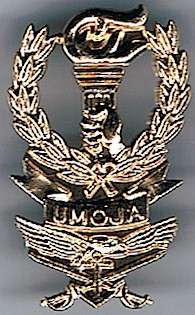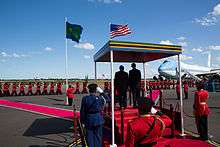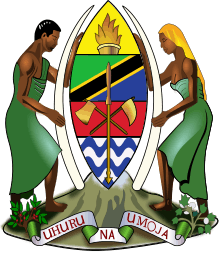Tanzania People's Defence Force
| Tanzania People's Defence Force | |
|---|---|
| Jeshi la Ulinzi la Wananchi wa Tanzania | |
|
Zanzibar, 12 Jan. 2004, celebration of 40 years' of the Revolution | |
 Tanzania People's Defence Force Staybrite cap badge | |
| Founded | 1 September 1964 |
| Service branches |
Army Naval Command Air Force Command |
| Headquarters | Upanga(Ngome), Dar es Salaam |
| Leadership | |
| Commander-in-Chief | John Magufuli |
| Minister of Defence and National Service | Hussein Mwinyi |
| Chief of Defence Forces | Venance Salvatory Mabeyo |
| Manpower | |
| Conscription | 18 years (voluntary) |
| Available for military service | 9,985,445, age 16–49 (2010 est.) |
| Fit for military service |
5,860,339 males, age 16–49 (2010 est.), 5,882,279 females, age 16–49 (2010 est.) |
| Reaching military age annually |
512,294 males (2010 est.), 514,164 females (2010 est.) |
| Active personnel | 27,000[1] (ranked 85th) |
| Reserve personnel | 80,000 |
| Expenditures | |
| Budget | $220,000,000 (2014 est.) |
| Percent of GDP | 0.9% (2012 est.) |
| Related articles | |
| History |
The Tanganyika Rifles Uganda–Tanzania War (1978-79) Mozambican Civil War 2008 invasion of Anjouan M23 rebellion |
| Ranks | Rank and insignia of the Tanzanian Armed Forces |
The Tanzania People’s Defence Force (TPDF) is the armed forces of Tanzania. They were set up in September 1964, following a mutiny by the former colonial military force: the Tanganyika Rifles. From its inception, it was ingrained in the troops of the new TPDF that they were a people’s force under civilian control. Unlike some of its neighbors, Tanzania has never suffered a coup d'état or civil war.
The TPDF was given a specific mission: to defend Tanzania and everything Tanzanian, especially the people and their political ideology. Tanzanian citizens are able to volunteer for military service from 15 years of age, and 18 years of age for compulsory military service upon graduation from secondary school. Conscript service obligation was 2 years as of 2004.
History
After an aborted mutiny in January 1964, the existing army was disbanded. The new force was titled the 'Tanganyika Military Force', from 25 January 1964 - 26 April 1964.[2] The Tanzanian government concluded that the former British model was not appropriate for the needs of an independent African state.[3] Fresh recruits were sourced from the Tanganyika African National Union youth wing.[4] After the merge of Tanganyika and Zanzibar, the force was renamed the United Republic Military Force from 27 April 1964.[2] For the first few years of the TPDF, the army was even smaller than the disbanded 2,000 strong Tanganyika Rifles, the air force was minuscule, and no navy had yet been formed. However the army was four battalions strong by 1967.[5]
From 1964 to 1974, the TPDF was commanded by Mrisho S.H. Sarakikya, trained at the Royal Military Academy Sandhurst, who was promoted from lieutenant to brigadier in 1964 and became the force's first commander.[6] He was succeeded by Lieutenant General Abdallah Twalipo 1974-1980;[7]
In 1972, the International Institute for Strategic Studies listed the army with 10,000 personnel, four infantry battalions, 20 T-59, 14 Chinese T-62 light tanks, some BTR-40 and BTR-152, Soviet field artillery and Chinese mortars. 'Spares [were] short and not all equipment was serviceable.'[8]
The Uganda–Tanzania War happened in 1978–1979.
In 1992, the IISS listed the army with 45,000 personnel (some 20,000 conscripts), 3 division headquarters, 8 infantry brigades, one tank brigade, two field artillery battalions, two Anti-aircraft artillery battalions (6 batteries), two mortar, two anti-tank battalions, one engineer regiment (battalion sized), and one surface-to-air missile battalion with SA-3 and SA-6.[9] Equipment included 30 Chinese Type 59 and 32 T-54/55 main battle tanks.
In 2007 Tanzania pledged forces for the SADC Standby Brigade of the African Standby Force.[10]
Tanzanian Army
.jpg)
As of 2012, the army is gradually modernising and restructuring. Much of the inventory is in storage or unreliable.[11]
- 5 × infantry brigades
- 1 × armoured brigade
- 3 × artillery battalions
- 2 × air defence artillery battalions
- 1 × mortar battalion
- 2 × anti-tank battalions
- 121st Engineer Regiment (battalion size; unit identification from usaraf.army.mil and Flickr)
- 1 × central logistic/support group
Current Senior officers
- Chief of Defense Forces (CDF): General Venance Salvatory Mabeyo[12]
- Chief of Staff: Lieutenant General Yakub Mohamed [12]
- Commander of Land Forces: Major General George Msongole
- Commander of Air Forces: Brigadier General William Ingram [13]
- Commander of Naval Forces: Rear Admiral Richard Makanzo [14]
- Chief of National Service: Major Gen M.W. Isamuhyo [13]
Equipment
Air Force Command

The current Commander of the Tanzania Air Force Command is Major General William Ingram, who replaced Major General Joseph Kapwani upon the latter's retirement in January 2016. During a visit to Zimbabwe in March 2014, Kapwani commended Zimbabweans for 'remaining resolute and firmly safeguarding the country's sovereignty despite the suffering brought on by illegal Western sanctions.'[15] He made the remarks when he paid a courtesy call on Air Force of Zimbabwe Commander Air Marshal Perence Shiri at AFZ headquarters in Harare on 12 March 2014. General Kapwani, who was then the chair of the SADC Standing Aviation Committee, said he was in Zimbabwe to share experiences and strengthen relations.
A few of the Tanzanian air wing's transport remain serviceable. However, its Shenyang F-5s, and Chengdu F-7s are reported to fly only on rare occasions because of airworthiness problems.[16] Tanzania's long coastline means that transports are also used for patrol flights.
Contrary to what is usually reported, Tanzania never purchased any J-7Is from China. Instead, the Air Force Command was given 14 MiG-21MFs and two MiG-21Us by the USSR in 1974. Many of these were lost in different accidents due to the poor training, and two were said to have been lost when their pilots defected. Nevertheless, the few surviving examples took part in the Tanzania-Uganda War, in 1978-1979, when they saw much action, even if one was shot down in a case of friendly fire (it was lost to SA-7s fired by Tanzanian troops). The Tanzanian Army captured seven MiG-21MFs and one MiG-21U trainer from the Ugandan Air Force, as well as a considerable amount of spare parts. All of these were flown out to Mwanza air base, to enter service with the TPDF/AW. In 1998, Tanzania purchased four additional MiG-21MFs from the Ukraine, but these were reportedly in a very poor shape, and not used very often. Meanwhile, in 1980, an order for 10 F-7Bs and two TF-7s was issued to China, and in 1997 also two F-7Ns were purchased from Iran, together with four ex-Iraqi Air Force transports of an unknown type. Today, no Russian-supplied MiG-21s remain in service with the TPDF/AW, and only three or four F-7s remain operational. The TPDF/AW MiG-21MFs are now confirmed to have carried serials - in black or green - underneath the cockpit, but no details about these are known.

On 14 November 2013, Helmoed-Römer Heitman reported for Jane's Defence Weekly that a 'usually reliable source' had informed Jane's that the TPDF had replaced its 12 old CAC J-7 fighters with 14 new J-7s, twelve single-seat and two dual-seat. Deliveries were completed in 2011. Heitman also reported that the aircraft were fully operational at Dar es Salaam and Mwanza air bases.[17]
Recent estimates (2014) suggest that Tanzania's air force command operates 32 aircraft in 3 different types. It is believed they are operating 14 fighters, 11 fixed-wing attack aircraft and 7 transport aircraft. On October 1, 2015 a K-8 trainer jet of Tanzania Air Force Command crashed into the sea killing both pilots.[18]
Naval Command
The navy operates 9 fast attack craft and 12 patrol boats.
The current Commander of the Naval Command is Rear Admiral Richard Mutayoba Makanzo.
United Nations missions
.jpg)
As of 30 June 2013, the army is involved in the following United Nations peacekeeping missions:[19]
| Mission | Location | Number |
|---|---|---|
| United Nations Force Intervention Brigade (MONUSCO) | Goma, Democratic Republic of the Congo | 1,247 |
| UNAMID | Darfur, Sudan | 1,123 |
| United Nations Interim Force in Lebanon (UNIFIL) | Lebanon | 159 |
| United Nations Interim Security Force for Abyei (UNISFA) | Abyei | 5 |
| UNOCI | Ivory Coast | 4 |
| United Nations Mission in South Sudan (UNMISS) | South Sudan | 1 |
See also
References
- ↑ "CIA World Factbook: Tanzania". The World Factbook. 11 February 2013. Retrieved 16 February 2013.
- 1 2 Tungaraza, Casta. (1998). The transformation of civil-military relations in Tanzania, in Hutchful and Bathily The Military and Militarism in Africa. Dakar: CODESRIA.
- ↑ Keegan, John. World Armies. p. 698. ISBN 0-333-17236-1.
- ↑ For the rebuilding programme, see Lee, J. M. (1969), African Armies and Civil Order, International Institute for Strategic Studies/Chatto and Windus, 1969, 149-150.
- ↑ Parsons, 2003, 168.
- ↑ Irving Kaplan, Tanzania: A Country Study, Library of Congress Country Studies, First Edition, 1978, p. 248–249, and General Sarakikya attends Royal Military Academy's 50th reunion in Sandhurst, Arusha Times, 13–19 August 2011.
- ↑ Irving Kaplan, Tanzania: A Country Study, Library of Congress Country Studies, First Edition, 1978, p. 249, says that Twalipo took command in 1974.
- ↑ IISS, 1972-73, p. 40
- ↑ IISS Military Balance 1992-93, p. 211.
- ↑ Jane's Defence Weekly
- ↑ "Tanzania". Janes World Armies. Retrieved 22 June 2012.
- 1 2 "TSN : 404 - Page Not Found". dailynews.co.tz.
- 1 2 Abdu, Fatma (1 February 2016). "Tanzania: President Picks New TPDF Chief of Staff" – via AllAfrica.
- ↑ "Rear Admiral R S Laswai, Commander, Tanzanian Navy Visits India from 29 Aug to 01 sep 16". pib.nic.in. line feed character in
|title=at position 65 (help) - ↑ Zimbabwe: Tanzania Commander Hails Zimbabweans, The Herald (Zimbabwe) via AllAfrica, 13 March 2014.
- ↑ "OrBat Tanzania - MilAvia Press.com: Military Aviation Publications". www.milaviapress.com.
- ↑ Helmoed-Römer Heitman (Pretoria), Tanzania swaps old J-7 fighters for new ones, IHS Jane's Defence Weekly, 14 November 2013.
- ↑ "ASN Aircraft accident 01-OCT-2015 Hongdu K-8 Karakorum". aviation-safety.net. Retrieved 2016-03-08.
- ↑ "UN Mission's Summary detailed by Country" (PDF). Page 33, UN. 30 June 2013. Retrieved 17 July 2013.
Further reading

- Tanzania Refutes Cross Border Shelling
- Tony Avirgan and Martha Honey, 'War in Uganda,' Zed Press, London, UK, 1982
- Simon Baynham, Civil-Military Relations in Post-Independent Africa
- Donovan C. Chau, "Exploiting Africa: The Influence of Maoist China in Algeria, Ghana, and Tanzania," Naval Institute Press; 1st ed. (April 15, 2014)
- Michael G. Brooks, Kendall D. Gott. Security Assistance, U.S. and International Historical Perspectives: Proceedings of the Combat Studies Institute 2006 Military History Symposium. Government Printing Office. ISBN 978-0-16-087349-2. - includes China/Tanzania study
- Christopher Gallop, 'Letters from East Africa' Grosvenor House, UK, 2013 ISBN 978-1781486283
- Allison Herrick, Area Handbook for Tanzania, American University, 1968
- Irving Kaplan, Tanzania: A Country Study, Library of Congress Country Studies, First Edition, 1978, Second Edition, 1987.
- Murdo Morrison), ed. (2006). "World Air Forces". Flight International (Number 5063 ed.). London: Flight Global. p. 82. ISSN 0015-3710.
- Brian S. MacDonald (1990). "Africa armed forces". Military spending in developing countries (Number 5063 ed.). London. ISBN 978-0-88629-314-7.
- A.H. Omari, 2001. Civil–military Relations in Tanzania. Dar es Salaam: Centre for Foreign Relations.
- Timothy Parsons, The 1964 Army Mutinies and the Making of Modern East Africa
